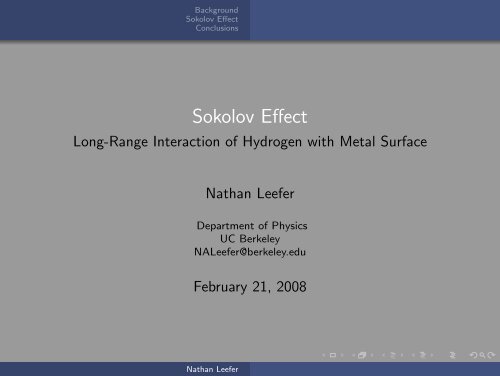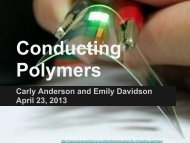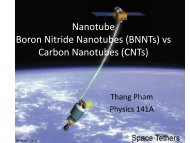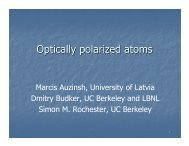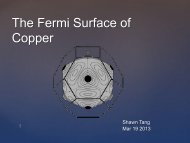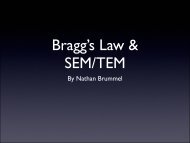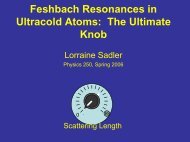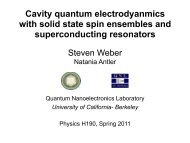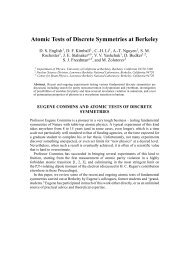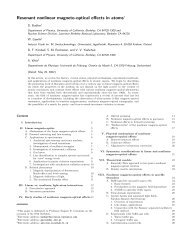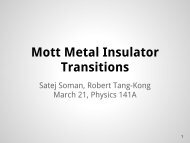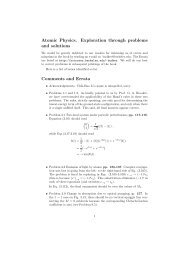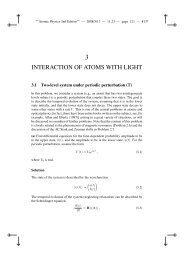Sokolov Effect - Long-Range Interaction of Hydrogen with Metal ...
Sokolov Effect - Long-Range Interaction of Hydrogen with Metal ...
Sokolov Effect - Long-Range Interaction of Hydrogen with Metal ...
Create successful ePaper yourself
Turn your PDF publications into a flip-book with our unique Google optimized e-Paper software.
Background<br />
<strong>Sokolov</strong> <strong>Effect</strong><br />
Conclusions<br />
<strong>Sokolov</strong> <strong>Effect</strong><br />
<strong>Long</strong>-<strong>Range</strong> <strong>Interaction</strong> <strong>of</strong> <strong>Hydrogen</strong> <strong>with</strong> <strong>Metal</strong> Surface<br />
Nathan Leefer<br />
Department <strong>of</strong> Physics<br />
UC Berkeley<br />
NALeefer@berkeley.edu<br />
February 21, 2008<br />
Nathan Leefer
Outline<br />
Background<br />
<strong>Sokolov</strong> <strong>Effect</strong><br />
Conclusions<br />
1 Background<br />
Neutral <strong>Hydrogen</strong><br />
Stark <strong>Effect</strong><br />
<strong>Hydrogen</strong> Atom Interferometer<br />
Nathan Leefer
Outline<br />
Background<br />
<strong>Sokolov</strong> <strong>Effect</strong><br />
Conclusions<br />
1 Background<br />
Neutral <strong>Hydrogen</strong><br />
Stark <strong>Effect</strong><br />
<strong>Hydrogen</strong> Atom Interferometer<br />
2 <strong>Sokolov</strong> <strong>Effect</strong><br />
Pamir<br />
Broken Theories<br />
Summary<br />
Dysprosium<br />
Nathan Leefer
Outline<br />
Background<br />
<strong>Sokolov</strong> <strong>Effect</strong><br />
Conclusions<br />
1 Background<br />
Neutral <strong>Hydrogen</strong><br />
Stark <strong>Effect</strong><br />
<strong>Hydrogen</strong> Atom Interferometer<br />
2 <strong>Sokolov</strong> <strong>Effect</strong><br />
Pamir<br />
Broken Theories<br />
Summary<br />
Dysprosium<br />
3 Conclusions<br />
Nathan Leefer
Background<br />
<strong>Sokolov</strong> <strong>Effect</strong><br />
Conclusions<br />
Energy Levels <strong>of</strong> <strong>Hydrogen</strong><br />
Neutral <strong>Hydrogen</strong><br />
Stark <strong>Effect</strong><br />
<strong>Hydrogen</strong> Atom Interferometer<br />
2 S 2 P<br />
1 S<br />
Nathan Leefer
Background<br />
<strong>Sokolov</strong> <strong>Effect</strong><br />
Conclusions<br />
Energy Levels <strong>of</strong> <strong>Hydrogen</strong><br />
Neutral <strong>Hydrogen</strong><br />
Stark <strong>Effect</strong><br />
<strong>Hydrogen</strong> Atom Interferometer<br />
2 S 2 P<br />
Lifetime <strong>of</strong> 2 P states is<br />
∼1.5 ns<br />
1 S<br />
Nathan Leefer
Background<br />
<strong>Sokolov</strong> <strong>Effect</strong><br />
Conclusions<br />
Energy Levels <strong>of</strong> <strong>Hydrogen</strong><br />
Neutral <strong>Hydrogen</strong><br />
Stark <strong>Effect</strong><br />
<strong>Hydrogen</strong> Atom Interferometer<br />
2 S 2 P<br />
Lifetime <strong>of</strong> 2 P states is<br />
∼1.5 ns<br />
120 nm<br />
1 S<br />
Nathan Leefer
2 S 12<br />
2 P 12<br />
Background<br />
<strong>Sokolov</strong> <strong>Effect</strong><br />
Conclusions<br />
Energy Levels <strong>of</strong> <strong>Hydrogen</strong><br />
Neutral <strong>Hydrogen</strong><br />
Stark <strong>Effect</strong><br />
<strong>Hydrogen</strong> Atom Interferometer<br />
2 P 32<br />
Lifetime <strong>of</strong> 2 P states is<br />
∼1.5 ns<br />
Fine-Structure effects lift<br />
degeneracies<br />
1 S 12<br />
Nathan Leefer
Background<br />
<strong>Sokolov</strong> <strong>Effect</strong><br />
Conclusions<br />
Energy Levels <strong>of</strong> <strong>Hydrogen</strong><br />
Neutral <strong>Hydrogen</strong><br />
Stark <strong>Effect</strong><br />
<strong>Hydrogen</strong> Atom Interferometer<br />
2 P 32<br />
Lifetime <strong>of</strong> 2 P states is<br />
2 S 12<br />
2 P 12<br />
∼1.5 ns<br />
Fine-Structure effects lift<br />
degeneracies<br />
Nathan Leefer
Background<br />
<strong>Sokolov</strong> <strong>Effect</strong><br />
Conclusions<br />
Energy Levels <strong>of</strong> <strong>Hydrogen</strong><br />
Neutral <strong>Hydrogen</strong><br />
Stark <strong>Effect</strong><br />
<strong>Hydrogen</strong> Atom Interferometer<br />
2 P 32<br />
Lifetime <strong>of</strong> 2 P states is<br />
2 S 12<br />
2 P 12<br />
∼1.5 ns<br />
Fine-Structure effects lift<br />
degeneracies<br />
Lamb Shift is on the order<br />
<strong>of</strong> 1 GHz<br />
Nathan Leefer
Background<br />
<strong>Sokolov</strong> <strong>Effect</strong><br />
Conclusions<br />
Neutral <strong>Hydrogen</strong><br />
Stark <strong>Effect</strong><br />
<strong>Hydrogen</strong> Atom Interferometer<br />
(Nearly) Degenerate Perturbation Theory<br />
H ′ = d E o + δ LS<br />
2 (|2S 1/2 >< 2S 1/2 | − |2P 1/2 >< 2P 1/2 |)<br />
2S 12<br />
2P 12<br />
Nathan Leefer
Background<br />
<strong>Sokolov</strong> <strong>Effect</strong><br />
Conclusions<br />
Neutral <strong>Hydrogen</strong><br />
Stark <strong>Effect</strong><br />
<strong>Hydrogen</strong> Atom Interferometer<br />
(Nearly) Degenerate Perturbation Theory<br />
H ′ = d E o + δ LS<br />
2 (|2S 1/2 >< 2S 1/2 | − |2P 1/2 >< 2P 1/2 |)<br />
H ′ nm =<br />
( δLS<br />
2<br />
d SP E o<br />
d SP E o<br />
Eigenvalues √ are<br />
δLS 2 + 4E o 2 dsp<br />
2<br />
± 1 2<br />
− δ LS<br />
2<br />
)<br />
2S 12<br />
2P 12<br />
Α2S 12 Β2P 12 <br />
E ⩵ ∆ LS 2 E o d sp<br />
Γ2S 12 Ξ2P 12 <br />
Nathan Leefer
Background<br />
<strong>Sokolov</strong> <strong>Effect</strong><br />
Conclusions<br />
Neutral <strong>Hydrogen</strong><br />
Stark <strong>Effect</strong><br />
<strong>Hydrogen</strong> Atom Interferometer<br />
(Nearly) Degenerate Perturbation Theory<br />
H ′ = d E o + δ LS<br />
2 (|2S 1/2 >< 2S 1/2 | − |2P 1/2 >< 2P 1/2 |)<br />
H ′ nm =<br />
( δLS<br />
2<br />
d SP E o<br />
d SP E o<br />
Eigenvalues √ are<br />
δLS 2 + 4E o 2 dsp<br />
2<br />
± 1 2<br />
New eigenstates are<br />
superpositions <strong>of</strong> old<br />
eigenstates<br />
− δ LS<br />
2<br />
)<br />
2S 12<br />
2P 12<br />
Α2S 12 Β2P 12 <br />
E ⩵ ∆ LS 2 E o d sp<br />
Γ2S 12 Ξ2P 12 <br />
Nathan Leefer
Background<br />
<strong>Sokolov</strong> <strong>Effect</strong><br />
Conclusions<br />
Neutral <strong>Hydrogen</strong><br />
Stark <strong>Effect</strong><br />
<strong>Hydrogen</strong> Atom Interferometer<br />
Atoms enter and leave<br />
E-Field non-adiabatically<br />
Nathan Leefer
Background<br />
<strong>Sokolov</strong> <strong>Effect</strong><br />
Conclusions<br />
Neutral <strong>Hydrogen</strong><br />
Stark <strong>Effect</strong><br />
<strong>Hydrogen</strong> Atom Interferometer<br />
Atoms enter and leave<br />
E-Field non-adiabatically<br />
Atoms leaving field have<br />
2 P 1/2 component<br />
Nathan Leefer
Background<br />
<strong>Sokolov</strong> <strong>Effect</strong><br />
Conclusions<br />
Neutral <strong>Hydrogen</strong><br />
Stark <strong>Effect</strong><br />
<strong>Hydrogen</strong> Atom Interferometer<br />
Atoms enter and leave<br />
E-Field non-adiabatically<br />
Atoms leaving field have<br />
2 P 1/2 component<br />
Acquired phase depends on<br />
energy difference and time<br />
in field<br />
√<br />
c(2P 1/2 ) ∝ cos( δLS 2 + 4E o 2 dsp 2 T )<br />
Nathan Leefer
Optical Analogue<br />
Background<br />
<strong>Sokolov</strong> <strong>Effect</strong><br />
Conclusions<br />
Neutral <strong>Hydrogen</strong><br />
Stark <strong>Effect</strong><br />
<strong>Hydrogen</strong> Atom Interferometer<br />
This set-up is analogous to an optical interferometer<br />
Nathan Leefer
Background<br />
<strong>Sokolov</strong> <strong>Effect</strong><br />
Conclusions<br />
Measurement <strong>of</strong> Lamb Shift<br />
Pamir<br />
Broken Theories<br />
Summary<br />
Dysprosium<br />
Pamir<br />
Nathan Leefer
Initial Results<br />
Background<br />
<strong>Sokolov</strong> <strong>Effect</strong><br />
Conclusions<br />
Pamir<br />
Broken Theories<br />
Summary<br />
Dysprosium<br />
Problems:<br />
Difficult to assess systematic<br />
errors<br />
Nathan Leefer
Initial Results<br />
Background<br />
<strong>Sokolov</strong> <strong>Effect</strong><br />
Conclusions<br />
Pamir<br />
Broken Theories<br />
Summary<br />
Dysprosium<br />
Problems:<br />
Difficult to assess systematic<br />
errors<br />
Non-trivial electric field near<br />
entrance and exit slits<br />
Nathan Leefer
Double Interferometer<br />
Background<br />
<strong>Sokolov</strong> <strong>Effect</strong><br />
Conclusions<br />
Pamir<br />
Broken Theories<br />
Summary<br />
Dysprosium<br />
Use two interferometers<br />
separated by distance ’l’<br />
Nathan Leefer
Double Interferometer<br />
Background<br />
<strong>Sokolov</strong> <strong>Effect</strong><br />
Conclusions<br />
Pamir<br />
Broken Theories<br />
Summary<br />
Dysprosium<br />
Use two interferometers<br />
separated by distance ’l’<br />
Oscillation period <strong>of</strong> 2P 1/2<br />
intensity depends only on<br />
Lamb-Shift and velocity<br />
Nathan Leefer
Double Interferometer<br />
Background<br />
<strong>Sokolov</strong> <strong>Effect</strong><br />
Conclusions<br />
Pamir<br />
Broken Theories<br />
Summary<br />
Dysprosium<br />
Use two interferometers<br />
separated by distance ’l’<br />
Oscillation period <strong>of</strong> 2P 1/2<br />
intensity depends only on<br />
Lamb-Shift and velocity<br />
<strong>Sokolov</strong> Yu L, Yakovlev V P, Sov. Phys. JEPT 56 7<br />
(1982)<br />
<strong>Sokolov</strong> Yu L, in Proc. 2nd Int. Conf. on Precision<br />
Measurements and Fundamental Constants II (1981)<br />
Nathan Leefer
Demon Field<br />
Background<br />
<strong>Sokolov</strong> <strong>Effect</strong><br />
Conclusions<br />
Pamir<br />
Broken Theories<br />
Summary<br />
Dysprosium<br />
Now the second electric field is turned <strong>of</strong>f<br />
Nathan Leefer
Background<br />
<strong>Sokolov</strong> <strong>Effect</strong><br />
Conclusions<br />
First Candidate: Stray Charges<br />
Pamir<br />
Broken Theories<br />
Summary<br />
Dysprosium<br />
<strong>Effect</strong>ive electric field corresponds to 10-12 V/cm<br />
Nathan Leefer
Background<br />
<strong>Sokolov</strong> <strong>Effect</strong><br />
Conclusions<br />
First Candidate: Stray Charges<br />
Pamir<br />
Broken Theories<br />
Summary<br />
Dysprosium<br />
<strong>Effect</strong>ive electric field corresponds to 10-12 V/cm<br />
To confirm predictions modify set-up accordingly...<br />
Nathan Leefer
Background<br />
<strong>Sokolov</strong> <strong>Effect</strong><br />
Conclusions<br />
First Candidate: Stray Charges<br />
Pamir<br />
Broken Theories<br />
Summary<br />
Dysprosium<br />
<strong>Effect</strong>ive electric field corresponds to 10-12 V/cm<br />
To confirm predictions modify set-up accordingly...<br />
Nathan Leefer
Background<br />
<strong>Sokolov</strong> <strong>Effect</strong><br />
Conclusions<br />
First Candidate: Stray Charges<br />
Pamir<br />
Broken Theories<br />
Summary<br />
Dysprosium<br />
<strong>Effect</strong>ive electric field corresponds to 10-12 V/cm<br />
To confirm predictions modify set-up accordingly...<br />
<strong>Effect</strong>ive field must be orthogonal to first longitudinal field<br />
Nathan Leefer
Results<br />
Background<br />
<strong>Sokolov</strong> <strong>Effect</strong><br />
Conclusions<br />
Pamir<br />
Broken Theories<br />
Summary<br />
Dysprosium<br />
Nathan Leefer
Background<br />
<strong>Sokolov</strong> <strong>Effect</strong><br />
Conclusions<br />
Second Candidate: Beam Halo<br />
Pamir<br />
Broken Theories<br />
Summary<br />
Dysprosium<br />
Maybe diffraction halo <strong>of</strong> beam is interacting <strong>with</strong> metal<br />
surface<br />
Nathan Leefer
Background<br />
<strong>Sokolov</strong> <strong>Effect</strong><br />
Conclusions<br />
Second Candidate: Beam Halo<br />
Pamir<br />
Broken Theories<br />
Summary<br />
Dysprosium<br />
Maybe diffraction halo <strong>of</strong> beam is interacting <strong>with</strong> metal<br />
surface<br />
Beam size is 50 µm, slit width is 200 µm<br />
Nathan Leefer
Background<br />
<strong>Sokolov</strong> <strong>Effect</strong><br />
Conclusions<br />
Second Candidate: Beam Halo<br />
Pamir<br />
Broken Theories<br />
Summary<br />
Dysprosium<br />
Maybe diffraction halo <strong>of</strong> beam is interacting <strong>with</strong> metal<br />
surface<br />
Beam size is 50 µm, slit width is 200 µm<br />
Misalign beam to measure halo.<br />
Nathan Leefer
Background<br />
<strong>Sokolov</strong> <strong>Effect</strong><br />
Conclusions<br />
Second Candidate: Beam Halo<br />
Pamir<br />
Broken Theories<br />
Summary<br />
Dysprosium<br />
Maybe diffraction halo <strong>of</strong> beam is interacting <strong>with</strong> metal<br />
surface<br />
Beam size is 50 µm, slit width is 200 µm<br />
Misalign beam to measure halo.<br />
Nathan Leefer
Background<br />
<strong>Sokolov</strong> <strong>Effect</strong><br />
Conclusions<br />
Second Candidate: Beam Halo<br />
Pamir<br />
Broken Theories<br />
Summary<br />
Dysprosium<br />
Maybe diffraction halo <strong>of</strong> beam is interacting <strong>with</strong> metal<br />
surface<br />
Beam size is 50 µm, slit width is 200 µm<br />
Misalign beam to measure halo.<br />
Beam halo is small: 1.4 µm<br />
Nathan Leefer
Background<br />
<strong>Sokolov</strong> <strong>Effect</strong><br />
Conclusions<br />
Third Candidate: Entanglement?<br />
Pamir<br />
Broken Theories<br />
Summary<br />
Dysprosium<br />
B B Kadomtsev proposes the effect is due to the creation <strong>of</strong><br />
entangled states<br />
Nathan Leefer
Background<br />
<strong>Sokolov</strong> <strong>Effect</strong><br />
Conclusions<br />
Third Candidate: Entanglement?<br />
Pamir<br />
Broken Theories<br />
Summary<br />
Dysprosium<br />
B B Kadomtsev proposes the effect is due to the creation <strong>of</strong><br />
entangled states<br />
Nathan Leefer
Background<br />
<strong>Sokolov</strong> <strong>Effect</strong><br />
Conclusions<br />
Third Candidate: Entanglement?<br />
Pamir<br />
Broken Theories<br />
Summary<br />
Dysprosium<br />
B B Kadomtsev proposes the effect is due to the creation <strong>of</strong><br />
entangled states<br />
Magnitude <strong>of</strong> effect should depend on material properties <strong>of</strong><br />
conductor<br />
Nathan Leefer
Results<br />
Background<br />
<strong>Sokolov</strong> <strong>Effect</strong><br />
Conclusions<br />
Pamir<br />
Broken Theories<br />
Summary<br />
Dysprosium<br />
Nathan Leefer
Background<br />
<strong>Sokolov</strong> <strong>Effect</strong><br />
Conclusions<br />
Pamir<br />
Broken Theories<br />
Summary<br />
Dysprosium<br />
Kadomtsev’s Theory also makes predictions<br />
Nathan Leefer
Background<br />
<strong>Sokolov</strong> <strong>Effect</strong><br />
Conclusions<br />
Pamir<br />
Broken Theories<br />
Summary<br />
Dysprosium<br />
Kadomtsev’s Theory also makes predictions<br />
Nathan Leefer
The Consensus?<br />
Background<br />
<strong>Sokolov</strong> <strong>Effect</strong><br />
Conclusions<br />
Pamir<br />
Broken Theories<br />
Summary<br />
Dysprosium<br />
The experiment is modified twice more<br />
Nathan Leefer
The Consensus?<br />
Background<br />
<strong>Sokolov</strong> <strong>Effect</strong><br />
Conclusions<br />
Pamir<br />
Broken Theories<br />
Summary<br />
Dysprosium<br />
The experiment is modified twice more<br />
Nathan Leefer
Summary <strong>of</strong> Results<br />
Background<br />
<strong>Sokolov</strong> <strong>Effect</strong><br />
Conclusions<br />
Pamir<br />
Broken Theories<br />
Summary<br />
Dysprosium<br />
All discussed theories have failed to describe experimental<br />
results<br />
Nathan Leefer
Summary <strong>of</strong> Results<br />
Background<br />
<strong>Sokolov</strong> <strong>Effect</strong><br />
Conclusions<br />
Pamir<br />
Broken Theories<br />
Summary<br />
Dysprosium<br />
All discussed theories have failed to describe experimental<br />
results<br />
Other proposed candidates (casimir force, image charges, etc)<br />
are not consistent <strong>with</strong> the magnitude <strong>of</strong> observed effect<br />
Nathan Leefer
Summary <strong>of</strong> Results<br />
Background<br />
<strong>Sokolov</strong> <strong>Effect</strong><br />
Conclusions<br />
Pamir<br />
Broken Theories<br />
Summary<br />
Dysprosium<br />
All discussed theories have failed to describe experimental<br />
results<br />
Other proposed candidates (casimir force, image charges, etc)<br />
are not consistent <strong>with</strong> the magnitude <strong>of</strong> observed effect<br />
No theories consistent <strong>with</strong> experimental results have been<br />
proposed<br />
Nathan Leefer
Atomic Dysprosium<br />
Background<br />
<strong>Sokolov</strong> <strong>Effect</strong><br />
Conclusions<br />
Pamir<br />
Broken Theories<br />
Summary<br />
Dysprosium<br />
Atomic Dysprosium also has nearly degenerate states <strong>of</strong> opposite parity<br />
(3 MHz-GHz)<br />
Nathan Leefer
Atomic Dysprosium<br />
Background<br />
<strong>Sokolov</strong> <strong>Effect</strong><br />
Conclusions<br />
Pamir<br />
Broken Theories<br />
Summary<br />
Dysprosium<br />
Atomic Dysprosium also has nearly degenerate states <strong>of</strong> opposite parity<br />
(3 MHz-GHz)<br />
Nathan Leefer
Atomic Dysprosium<br />
Background<br />
<strong>Sokolov</strong> <strong>Effect</strong><br />
Conclusions<br />
Pamir<br />
Broken Theories<br />
Summary<br />
Dysprosium<br />
Atomic Dysprosium also has nearly degenerate states <strong>of</strong> opposite parity<br />
(3 MHz-GHz)<br />
Dysprosium may be a sensitive tool for measuring this effect<br />
Nathan Leefer
Summary<br />
Background<br />
<strong>Sokolov</strong> <strong>Effect</strong><br />
Conclusions<br />
Level structure <strong>of</strong> hydrogen and Stark <strong>Effect</strong><br />
Nathan Leefer
Summary<br />
Background<br />
<strong>Sokolov</strong> <strong>Effect</strong><br />
Conclusions<br />
Level structure <strong>of</strong> hydrogen and Stark <strong>Effect</strong><br />
Near degeneracy <strong>of</strong> 2S 1/2 and 2P 1/2 states to electric fields<br />
makes hydrogen ideal for use in atomic interferometer<br />
Nathan Leefer
Summary<br />
Background<br />
<strong>Sokolov</strong> <strong>Effect</strong><br />
Conclusions<br />
Level structure <strong>of</strong> hydrogen and Stark <strong>Effect</strong><br />
Near degeneracy <strong>of</strong> 2S 1/2 and 2P 1/2 states to electric fields<br />
makes hydrogen ideal for use in atomic interferometer<br />
There exists an unexplained interaction between hydrogen<br />
atoms and metal surfaces<br />
Nathan Leefer
Background<br />
<strong>Sokolov</strong> <strong>Effect</strong><br />
Conclusions<br />
Yu L <strong>Sokolov</strong><br />
Physics-Uspekhi 42 (5) 481–503 (1999)<br />
Yu L <strong>Sokolov</strong>, V P Yakovlev, V G Pal’chikov, and Yu A Pchelin<br />
Eur. Phys. J. D 20 27-46 (2002)<br />
Yu A Kucheryaev , V G Palchikov, Yu A Pchelin, Yu L <strong>Sokolov</strong>, and V P Yakovlev<br />
JETP Letters 81 (12) 644–646 (2005)<br />
Yu L <strong>Sokolov</strong>, V P Yakovlev<br />
Sov. Phys. JETP 56 7 (1982)<br />
Yu L <strong>Sokolov</strong><br />
in Proc. 2nd Int. Conf. on Precision Measurements and Fundamental Constants II (1981)<br />
B B Kadomtsev<br />
Phys. Lett. A 210 371-376 (1996)<br />
S T Belyaev<br />
Eur. Phys. J. D 25 247-252 (2003)<br />
Nathan Leefer


